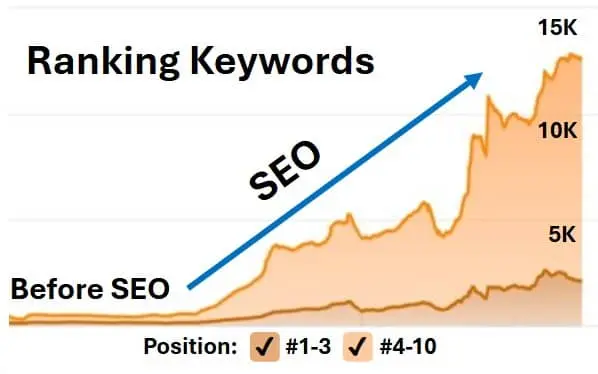I’m not selling any web design or hosting services. Although, I’ve built websites for close to 15 years. And this is the guide I wish I had starting out. The best financial advisor web design should be simple, low cost, and great for marketing.
In other words, I can uphold fiduciary responsibility. On top of learning web design, I’ve passed the three CFA exams. You've found a rare combo of someone who understands finance, websites, and marketing. Feel free to reach out with any question.
Financial Advisor Web Design Guide

Here’s a quick guide you can use to jump around on-page. Also, feel free to bookmark or save this page. It’s packed with many time-tested lessons.
- Websites for Financial Advisors
- Best Website Design: 2 Rules for Better Engagement
- Why WordPress is the Most Popular
- Registering a Domain Name
- Picking a Website Hosting Service
- Website Structure and Disclaimers
You might be tempted to skip the first few sections, but they’re similar to a client intake form. They can help draw attention to the bigger picture.
If you don’t have experience building websites – similar to your clients with financial planning and investing – it’s easy to overlook details that matter. For example, there are two big website mistakes I hope to help you avoid...
Websites for Financial Advisors
Friends have asked me over the years to build them websites. However, for many businesses, I’ve recommended against it. It’s more of a distraction.
It’s often best to build pages on social platforms where their customers already visit. But for industries like finance, it’s useful to have a professional-looking website. Before people trust you with their money, they tend to do more research. And it often starts with a Google search.
If your financial advisor website is a top result, it helps you control your brand and bring in new clients. Even in the age of AI, having your own website gives you more control.
For another benefit, your website traffic should also compound. It’s similar to compounding investment returns. There’s some upfront effort to setting up a website, but then the value you get from your site grows. With good website design, it requires little-to-no ongoing effort.
Here’s one of the websites I managed...

Before we dive into setting up a financial advisor website, there are two key rules to keep in mind.
Best Website Design: 2 Rules for Better Engagement
Here are two counterintuitive rules I’ve learned over the years.
Many people focus on sounding smart and fancy web design. However, this is often a trap. It leads to more complexity and cost. Both upfront, and over the long-term.
On top of that, it leads to lower engagement and conversions. I’ve seen these mistakes many times over.
With smaller sites, it’s hard to isolate what works. Most tests are not statistically significant. But having managed websites that grow to millions of views, I’ve seen first-hand what works. You can use the same techniques.
I’ve also written short-form lead gen copy that’s brought in over 600,000 e-letter subscribers. Then with fine-tuned sales funnels, that lead to over $12 million in sales.
1. Web Design: Build Simple Sites
Financial advisor web design should be simple. There’s no need to clutter your pages with many distracting images and other elements. People have different design preferences. By sticking to simple, you won’t deter potential clients. Simple and professional.
This approach is easier to build and maintain. It leads to less technical complexity and fewer security threats. It can also come with accessibility benefits. This can make it easier for an older people to navigate. A common audience for many wealth advisors.
With this approach, you can also focus on a clear call-to-action (CTA). You can direct viewers to contact you or your team.
2. Write Below the 8th Grade Reading Level
Even for educated audiences, a simple message is better. Avoid jargon.
At one of the largest investment newsletters, we had a rule to write at or below the 8th grade reading level. And many of our readers were savvy professionals: financial advisors, doctors, lawyers, engineers, etc. Some even subscribed to $4,000+ (annual subscription) newsletters I sent out.
Many people want to sound smart. But it’s a trap that pushes people away. This is a good rule to keep in mind for your financial advisor website. It also applies to emails and other communications.
If you’re looking for help with financial copy, check out our SEO Writing Services.
Why WordPress is the Most Popular
It’s ok to go with the website builders like the ones below...
- Squarespace
- Wix
- Webflow
- Weebly
But there’s a reason your see many paid ads for these platforms. They cost more and lock you into their platforms. Their website performance is also often slower which isn’t good for SEO.
They advertise their ease-of-use for building websites. However, there’s a much better option that’s just as easy to use. It's lower cost and comes with better support...
WordPress! Here’s why 43% of all websites use WordPress...
It’s free and open source. With wide developer testing and support, it’s one of the best platforms. On top of that, there are tons of plugins to meet almost any website goals. For most any WordPress topic, you can find YouTube tutorials and other guides online.
However, even within WordPress, there are many website services to avoid.
Financial Website Templates: Don’t Buy WordPress Themes
Going the WordPress route, there are lots of different themes to choose from. Check out some of the themes on WordPress.org.
However, as mentioned, it’s best to keep it simple. And don’t get sucked into a custom theme with little support and lots of add-ons to buy. I see this all too often and then a year or two down the road, lots of technical issues come up.
Here’s one of my favorite free themes for financial advisor web design. With over one million downloads, it continues to get great support.
There are other website builders that help with WordPress design. Elementor is a big one. However, it adds complexity and costs. Even with little web building experience, I’d advise against locking into that web designer. You’ll often find them bundled with themes.
Registering a Domain Name
Picking a domain name should come with some thought. If you have a name for your financial advising business, that’d be good to go with (assuming it’s available). Or you might want to use your personal name. This can help you build both your brand and business reputation.
Here’s one of many sites that lets you search domain names availability.
However, there’s another useful route for website names...
Google tends to rank websites better when the base domain matches the search. For example, one focus for this website is SEO for Startups and small businesses. That’s why I chose SEOStartups.com.
For your financial advisor website, you might want to include “advisor” and your city’s name. To learn more about this strategy, here’s a guide to SEO for Financial Advisors. This can help you reach more people to build your financial advising business.
Once you have a domain picked out, you might want to wait before buying it. Some hosting providers will let you register a free domain...
Picking a Website Hosting Service
Here’s a list of some popular web hosting providers...
- Hostinger
- GoDaddy
- Bluehost
- HostGator
- WordPress.com
- SiteGround
I’ve used many of them and I’d say GoDaddy was the worst. As a small website owner (or multiple websites in my case), these providers can’t deliver direct support.
Either way, they all should have easy installs for setting up a WordPress website. They usually have guides on their sites as well. For example, if you bought a domain elsewhere, they’ll show you how to point it to their servers to host. And for even better guides, you can find them on YouTube and elsewhere.
When picking your provider, also take advantage of new customer discounts. I got a steep discount on a two-year plan a few years ago from Hostinger for $60. Then it renewed at $120 for another two years. For most financial advisor websites, this service should easily cover your web traffic.
No matter what provider you decide one, make sure to check for discounts. As mentioned, some offer a free domain name as a first-time hosting customer. Setting up your financial advisor website should be low-cost.
When going through big providers, they tend to have lots of security features built in as well. For example, they often come with free SSL (TLS) certs. You shouldn’t have to do anything to set this up.
If you plan to accept payments and have other features on your site, security becomes even more important (along with regulations around them).
If you install any WordPress plugins, make sure you pick ones with good ongoing support. Also, keep them updated. For example, you might use a plugin to let your viewers sign up for your newsletter... or show a calendar to schedule a meeting.
Website Structure and Disclaimers
Sticking to a simple design, there are a few core pages to have on a financial advisor website...
- Homepage
- Contact
- About
- Privacy Policy/Disclaimers
That’s a good base for any website. It can help people find and learn about your business. And going further, here are some more pages to consider...
- Services
- Team Members
- Client Stories
- FAQ
- Blog
There’s no-hard-and-fast rule for this website design. You can pick what makes the most sense for your financial advising business.
Although, I have two main pieces of advice. Try to design you site structure to future proof it as you grow. This can make it easier to maintain. And that ties into the other main point I keep hitting on. Not to beat a dead horse... For the best financial advisor website design, keep it simple.
Your homepage will have the most traffic. That's why it's best to optimize it with a clear CTA. This helps you turn viewers into customers. For example, a contact form for your main financial service. Or a link to a calendar to schedule a new customer call.
Once you have these pages in place, it takes little-to-no time to maintain. Some upfront work on your financial advisor web design should pay dividends. Passive dividends that grow over time.
Website Marketing for Financial Advisors
With this guide, you have a map for building your financial advisor website. Don’t travel down the wrong paths. Many will try to lure you into their platforms and sales funnels. And as mentioned, I’ve been building and hosting website for well over a decade.
It can take some time, but Google should start serving up your site for branded searches. Then if you want to capture even more potential clients from Google, you can advertise your website other ways. And one of my favorites is SEO articles. If you’re looking for help with articles, check out our Content Writing Services.
I hope this insight helps and feel free to reach out with any questions.